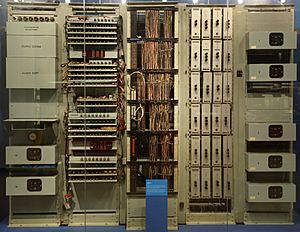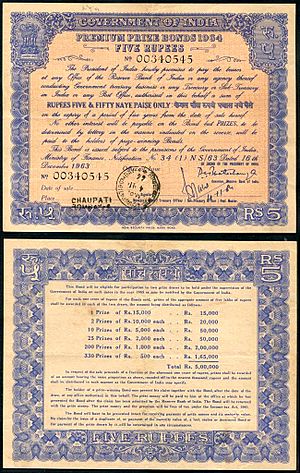Premium Bonds facts for kids
Premium Bonds are a special way to save money in the United Kingdom. They are like a savings account, but instead of earning regular interest, you get a chance to win tax-free prizes every month! The UK government has run this scheme since 1956. It is currently managed by National Savings and Investments, which is a government agency.
When you buy Premium Bonds, your money is not gambled away. Instead, the government uses the interest that would normally be paid on your savings to create a big prize fund. Then, a special computer picks random numbers, and if your bond number is chosen, you win a prize! The government promises to give you your original money back whenever you ask for it.
The government adds interest to the prize fund. As of January 2025, this rate was 4% per year. From this fund, monthly prizes are given out. The special machine that picks the winning numbers is called ERNIE. This stands for "Electronic Random Number Indicator Equipment". Prizes can be anywhere from £25 up to a huge £1,000,000! Since December 2024, the chance of a £1 bond winning a prize in a month has been 1 in 22,000.
You can buy Premium Bonds at any time. However, they need to be held for a full calendar month before they can win a prize. For example, if you bought a bond in mid-May, it would need to be held all through June to be in the July draw. If you win a prize and use that money to buy more bonds, those new bonds can enter the draw the very next month.
Your bond numbers stay in the draw every month until you decide to cash them in. Since 2015, each person can own up to £50,000 worth of bonds. Since February 2019, the smallest amount you can buy is £25. As of January 2025, there were over 128.7 billion eligible Premium Bonds, each worth £1.
When Premium Bonds first started in 1957, the only other similar game in the UK was the football pools. The National Lottery did not even exist until 1994. Even though there are many ways to gamble now, over 24 million people in the UK still hold Premium Bonds. That is more than one in three people!
Contents
History of Premium Bonds
The idea of a "premium bond" has been around for a long time. It meant a bond that did not pay regular interest but could win prizes in a lottery.
The Premium Bonds we know today were started by Harold Macmillan in 1956. He was the Chancellor of the Exchequer (like the UK's finance minister) at the time. He introduced them in his Budget speech on April 17, 1956. The goal was to help control rising prices and encourage people to save money.
On November 1, 1956, the first bond was bought by the Lord Mayor of London, Sir Cuthbert Ackroyd, for £1. The Premium Bonds office was first in St Annes-on-Sea, Lancashire. It later moved to Blackpool in 1978.
How Much Could People Hold?
Over the years, the maximum amount of Premium Bonds a person could hold changed. Here is how it increased:
| Date | Amount |
|---|---|
| 01-11-1956 | £500 |
| 01-08-1960 | £800 |
| 21-04-1964 | £1,000 |
| 14-04-1967 | £1,250 |
| 01-04-1971 | £2,000 |
| 11-09-1978 | £3,000 |
| 21-04-1980 | £10,000 |
| 03-04-1993 | £20,000 |
| 12-05-2003 | £30,000 |
| 01-06-2014 | £40,000 |
| 01-06-2015 | £50,000 |
Winning Prizes
Winners of the biggest prizes are usually told on the first working day of the month. The actual draw date can change. The online prize checker is updated a few days later. If you win the top £1 million prize, a special employee from NS&I, called "Agent Million," tells you in person. This usually happens the day before the first working day of the month. However, during the COVID-19 pandemic in the United Kingdom, these in-person visits were stopped for a while starting in May 2020.
You can check if you have won any prizes on the National Savings & Investment website or their smartphone app. These show winning bond numbers for the last six months. Older winning numbers can also be checked in the London Gazette Premium Bonds Unclaimed Prizes Supplement.
Odds of Winning
The chance of winning a prize changes over time. This is because the interest rate that goes into the prize fund can change. For example, in December 2008, the odds of winning became lower. This was due to a drop in the Bank of England's interest rate. Many people were unhappy, saying Premium Bonds were "worthless" then. Someone with £30,000 invested might win only 10 prizes a year, compared to 15 the year before.
From January 1, 2009, the odds of a £1 bond winning a prize were 1 in 36,000. By October 2009, they improved to 1 in 24,000. In October 2013, the odds were 1 in 26,000. Then, in November 2017, they went back to 1 in 24,500.
As of December 2024, the odds of winning are 1 in 22,000. This means if you have the maximum £50,000 worth of bonds, you could expect to win about 27 prizes each year.
How Prizes Are Given Out
The total prize fund each month is equal to one month's interest on all the bonds that are eligible for the draw. The annual interest rate is set by NS&I. It was 1.40% in December 2017, then dropped to 1.00% in December 2020. It increased to 2.2% in October 2022, then to 3% in January 2023. As of April 2025, it is 3.8%.
The table below shows how the prizes were planned for the January 2025 draw:
| Prize band | Prize value | Estimated number of prizes each month | Odds of winning exactly this amount with a £1 bond | Odds of winning at least this amount with a £1 bond |
|---|---|---|---|---|
| Higher value 10% of the prize fund |
£1,000,000 | 2 | 1 in 64.36 billion | 1 in 64.36 billion |
| £100,000 | 82 | 1 in 1.57 billion | 1 in 1.53 billion | |
| £50,000 | 163 | 1 in 789,737,809 | 1 in 521,163,007 | |
| £25,000 | 328 | 1 in 392,461,168 | 1 in 223,873,500 | |
| £10,000 | 818 | 1 in 157,368,293 | 1 in 92,410,095 | |
| £5,000 | 1,636 | 1 in 78,684,147 | 1 in 42,498,271 | |
| Medium value 10% of the prize fund |
£1,000 | 17,163 | 1 in 7,500,278 | 1 in 6,375,162 |
| £500 | 51,489 | 1 in 2,500,093 | 1 in 1,795,835 | |
| Low value 80% of the prize fund |
£100 | 1,987,844 | 1 in 64,757 | 1 in 62,503 |
| £50 | 1,987,844 | 1 in 64,758 | 1 in 31,805 | |
| £25 | 1,803,871 | 1 in 71,364 | 1 in 22,000 | |
| Total value (January 2025) |
£429,090,875 | 5,851,240 |
ERNIE: The Prize-Picking Computer

ERNIE, which stands for "Electronic Random Number Indicator Equipment," is the name given to the special computers that pick the winning Premium Bond numbers. There have been five different ERNIE models so far. All of them create truly random numbers using natural, unpredictable changes in physical processes.
The first ERNIE was built in 1957 by a team led by Sidney Broadhurst. It was inspired by the Colossus computer, one of the world's first digital computers. ERNIE 1 made random numbers from the electrical "noise" created by special gas-filled tubes. The first draw using ERNIE 1 was on June 1, 1957. ERNIE 1 is now part of the collection at the Science Museum, London. It was on display there from 2008 to 2015.
ERNIE 2 took over from the first ERNIE in 1972.
ERNIE 3 arrived in 1988. It was about the size of a personal computer. By the end of its use, it took five and a half hours to complete its monthly draw.
In August 2004, ERNIE 4 started working. It was much faster than the original ERNIE, about 500 times faster! It could generate a million numbers in just one hour. The original ERNIE was the size of a van and only generated 2,000 numbers an hour. ERNIE 4 used tiny electrical noise from transistors to create its random numbers. Each month, the numbers ERNIE produced were checked by an independent government department to make sure they were truly random. ERNIE 4 is now at The National Museum of Computing at Bletchley Park.
ERNIE 5, the newest model, began operating in March 2019. It uses advanced quantum technology to create random numbers from light. This is a much faster method than the old "thermal noise" one. ERNIE 5 is 21,000 times faster than the first ERNIE. It can pick 3 million winners in just 12 minutes each month!
ERNIE in Popular Culture
ERNIE became quite famous and was even shown as a friendly character in early advertisements. People sometimes send ERNIE Valentine's Day cards, Christmas cards, and letters! The band Madness wrote a song called "E.R.N.I.E." on their 1980 album Absolutely. The band Jethro Tull also mentioned ERNIE in their album Thick as a Brick.
Similar Schemes in Other Countries
Premium Bonds, or similar prize-linked savings schemes, have existed in many other countries. Here are a few examples:
- In the Republic of Ireland, Prize Bonds have been available since early 1957.
- In Sweden, Premieobligationer (which means 'Premium bonds') usually last for five years. People who hold a certain number of these bonds are guaranteed to win at least one prize each year.
- In Denmark, Præmieobligation (also meaning 'Premium bonds') usually ran for five or ten years. These were physical bonds with a fixed prize list printed on them. The last of these bonds have now ended.
- In New Zealand, "Bonus Bonds" were started by the government in 1970. However, the scheme closed in August 2020 because low interest rates meant there was not enough money for prizes. At that time, 1.2 million people had invested NZD $3.2 billion.
Images for kids




